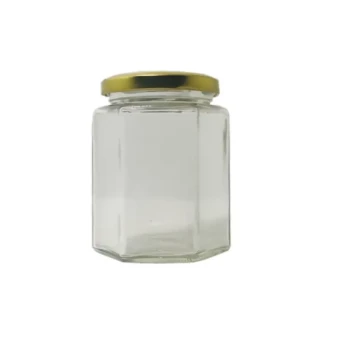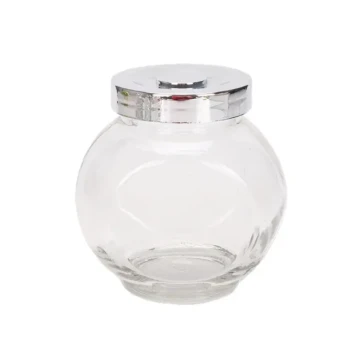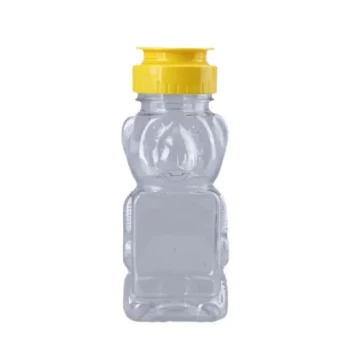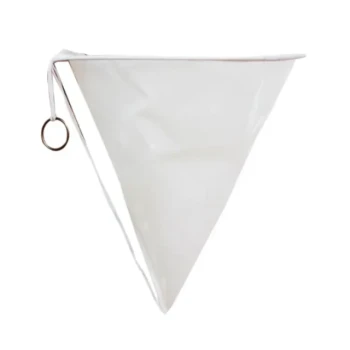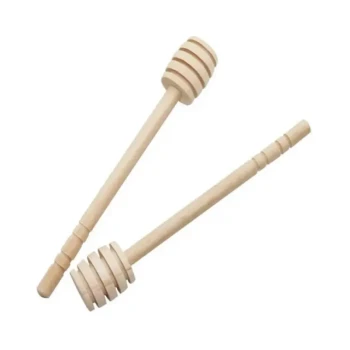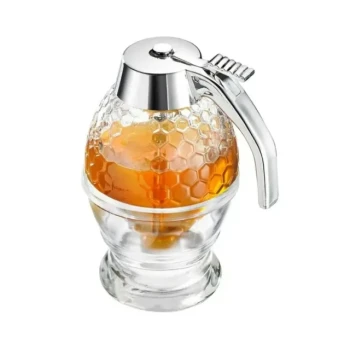For long-term storage, glass is the best material to store honey. An airtight glass jar is ideal because it is non-porous, impermeable, and will not absorb or impart any flavors, perfectly preserving the honey's natural taste and color. Food-grade plastic is a suitable alternative, but glass remains the superior choice for maintaining purity over time.
The ideal container for honey is one that is both non-reactive and airtight, like glass. However, protecting the honey from its environment—specifically temperature fluctuations, moisture, and sunlight—is just as critical as the material itself.
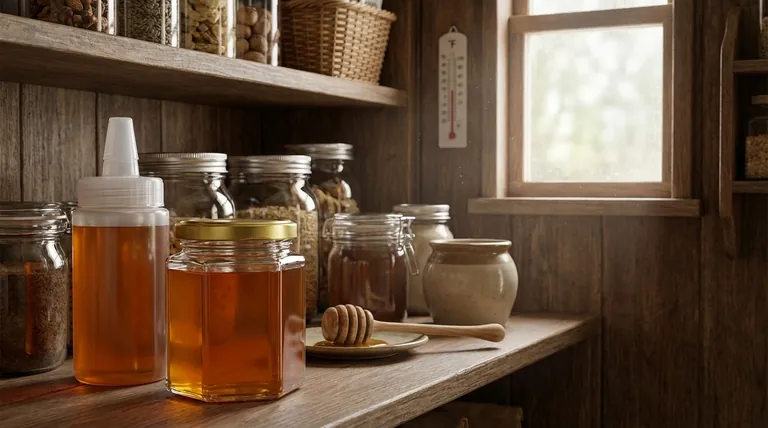
Why Container Material is Crucial for Honey Quality
The container you choose acts as the first line of defense in preserving the complex flavors and beneficial properties of honey. Different materials interact with honey in distinct ways.
Glass: The Gold Standard
Glass is chemically inert, meaning it won’t react with the natural acidity of honey. This ensures that the honey's taste remains pure and unaltered, no matter how long it's stored.
Its non-porous surface also prevents air and moisture from entering, which is critical for stopping fermentation. Furthermore, clear glass allows you to appreciate the honey's natural color and clarity.
Food-Grade Plastic: A Practical Alternative
Food-grade plastic containers are a common and acceptable option for honey storage. They are lightweight, shatter-resistant, and often more convenient for daily use, such as in squeeze bottles.
However, for very long-term storage, it's important to ensure the plastic is high-quality and specifically rated for food to avoid any potential for flavor transfer over time.
Metal Containers: The Material to Avoid
You should avoid storing honey in metal containers, especially those made of reactive metals. The natural acids in honey can cause the metal to oxidize.
This chemical reaction can not only contaminate the honey and alter its flavor but also increase its water content, creating a risk of fermentation.
Beyond the Material: Critical Environmental Factors
Simply choosing the right container isn't enough. Where and how you store that container plays an equally vital role in preserving your honey.
The Importance of an Airtight Seal
Honey is hygroscopic, meaning it naturally absorbs moisture from the air. A tight-fitting, airtight lid is non-negotiable to prevent this.
Excess moisture can raise the honey's water content above the ideal level (under 18%), which can lead to fermentation and spoilage.
Temperature Stability is Key
Honey is best stored at a stable room temperature, ideally between 65°F and 75°F. Extreme heat can degrade its delicate enzymes and darken its color, while cold temperatures accelerate crystallization.
Avoid storing honey near stoves, in sunny windows, or in the refrigerator. Constant temperature fluctuations are one of the fastest ways to degrade its quality.
The Damaging Effect of Light
Direct sunlight and UV radiation can break down the beneficial enzymes and antioxidants present in raw honey.
Storing your honey in a dark place like a pantry or cupboard is essential. For an extra layer of protection, you can use opaque or dark-colored glass jars, which shield the contents from light.
Understanding the Trade-offs
Choosing between suitable options often comes down to balancing purity with practicality.
Glass vs. Plastic
Glass offers unparalleled purity and is the clear winner for archival, long-term storage. Plastic offers convenience and durability, making it excellent for honey you plan to use regularly or for households with children.
Clear vs. Opaque Glass
While a clear glass jar beautifully displays the honey's amber glow, an opaque or dark-colored jar provides superior protection against light degradation. If your honey will sit on a countertop, opaque is the safer choice.
The Myth of Refrigeration
Many people mistakenly believe refrigeration keeps honey fresh. In reality, it does the opposite by significantly speeding up the natural process of crystallization, turning liquid honey into a thick, semi-solid state. While still edible, it becomes difficult to pour.
Making the Right Choice for Your Goal
Your storage strategy should align with how you plan to use your honey.
- If your primary focus is long-term preservation and purity: Use an airtight glass jar and store it in a dark, cool pantry.
- If your primary focus is everyday convenience: A food-grade plastic squeeze bottle is perfectly acceptable for honey you'll consume within a few months.
- If you want the best of both worlds: Store your bulk honey in a large glass jar in a pantry, and refill a smaller, convenient dispenser for daily use.
Proper storage ensures that every spoonful of honey you enjoy is as flavorful and perfect as the day it was harvested.
Summary Table:
| Material | Best For | Key Consideration |
|---|---|---|
| Glass | Long-term storage, purity | Chemically inert, non-porous, ideal for preserving flavor |
| Food-Grade Plastic | Everyday use, convenience | Lightweight and shatter-resistant; ensure high quality for long-term use |
| Metal | Avoid | Reactive; can oxidize and contaminate honey |
| Ideal Storage Conditions | Recommendation | Reason |
| Temperature | Stable, 65°F - 75°F | Prevents enzyme degradation and crystallization |
| Light | Dark place (pantry/cupboard) | Protects enzymes and antioxidants from UV damage |
| Seal | Airtight lid | Prevents moisture absorption and fermentation |
Ensure the quality of your honey from hive to table with professional storage solutions from HONESTBEE.
As a leading wholesale supplier to commercial apiaries and beekeeping equipment distributors, we understand that proper storage is critical for protecting your product's value. We provide the durable, high-quality containers and equipment you need to maintain honey purity, extend shelf life, and meet market demands.
Let us help you safeguard your harvest. Contact our experts today to discuss wholesale storage solutions tailored for your commercial operation.
Visual Guide
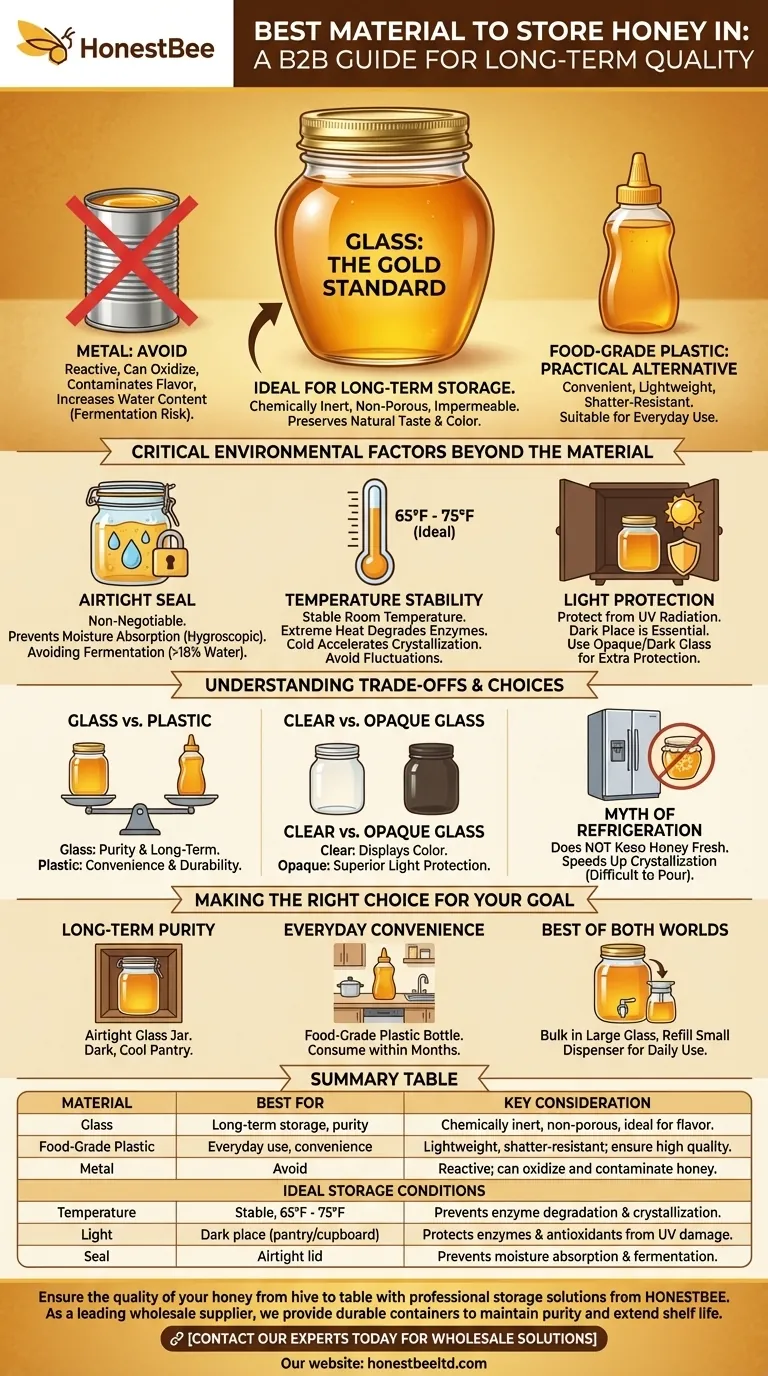
Related Products
- Hexagonal Glass Honey Jars with Metal Lug Caps Elegant Versatile Packaging
- Classic Drum Shaped Glass Honey Jar with Airtight Lid
- Inverted Squeezable Honey Jar with No Drip Flip Top Cap for Easy Pouring
- Classic Honey Bear Jars with Flip Top Dispensing Cap for Liquid Sweeteners
- Stainless Steel Honey Tank Stand for Honey Storage
People Also Ask
- What is the best way to jar honey? Preserve Quality with the Right Container
- What are the common types of honey packaging? A Guide to Glass, Plastic, Pouches & Tins
- What makes raw honey more aesthetically appealing than processed honey? Discover the Beauty of Authenticity
- What is the term for honey can absorb moisture from the air? Understanding Hygroscopy
- How many jars of honey do you get from a hive? Unlock Sustainable Harvesting Secrets
